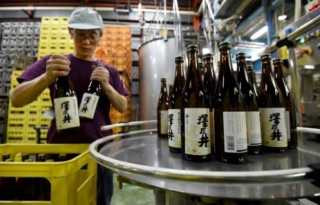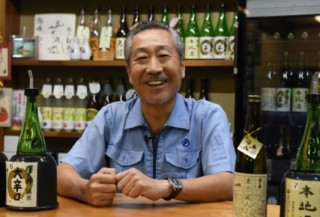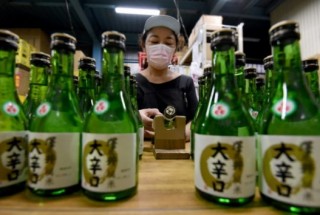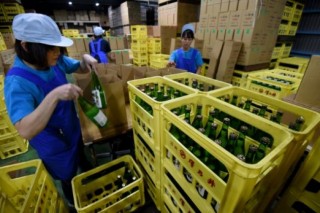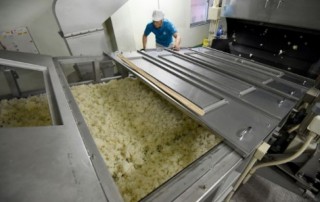Loading
Search
▼ Japanese Sake Looks Overseas as Local Market Dries Up
- Category:Gourmet
OME — Ozawa Shuzo brewery hums with activity as boxed bottles of sake are loaded onto trucks. But with the domestic market shrinking, more and more of it is bound for burgeoning overseas markets where the centuries old drink is all the rage.
The small establishment has recently drawn interest from potential new customers in Thailand, Vietnam and South Korea, on top of a coterie of existing ones in the United States, France and Singapore.
Sake, a fermented drink made of rice, has hit hard times in its homeland amid changing tastes, but manufacturers are welcoming growing popularity overseas.
A steady flow of tourists visiting Ozawa Shuzo could be a sign of things to come.
The small establishment has recently drawn interest from potential new customers in Thailand, Vietnam and South Korea, on top of a coterie of existing ones in the United States, France and Singapore.
Sake, a fermented drink made of rice, has hit hard times in its homeland amid changing tastes, but manufacturers are welcoming growing popularity overseas.
A steady flow of tourists visiting Ozawa Shuzo could be a sign of things to come.
“We cannot easily go abroad to explain what sake is all about, so by doing this (tours) at our brewery I hope visitors will get a better understanding of its value,” Junichiro Ozawa, president of the 300-year-old Ozawa Shuzo, told AFP at his brewery on Tokyo’s mountainous western fringe.
Underlining sake’s increasing global renown, the influential guide Robert Parker’s Wine Advocate this month issued ratings for the beverage.
Sake exports have doubled in the past decade to some 18,180 kilolitres, according to Japanese government figures, with the United States the largest single foreign market, accounting for about one-quarter of the total.
Underlining sake’s increasing global renown, the influential guide Robert Parker’s Wine Advocate this month issued ratings for the beverage.
Sake exports have doubled in the past decade to some 18,180 kilolitres, according to Japanese government figures, with the United States the largest single foreign market, accounting for about one-quarter of the total.
Impressive growth, but that is just three percent of total shipments, suggesting plenty of room for further expansion abroad. Major export destinations are the US, Taiwan, Hong Kong, China and South Korea, according to the agriculture ministry, making up 70 percent of the total.
Shipments to fastest-growing market China shot up more than three-fold between 2008 and last year, while they more than doubled to South Korea during that time.
In Hong Kong, where Japanese food and culture are popular, sake has been appearing on more and more restaurant menus in recent years.
“Compared to when I first started out in the business, people have increasingly become more interested in appreciating and learning more about sake,” said Stephen Tse, who manages a Japanese restaurant in Tai Hang, an upscale neighbourhood in the southern Chinese city.
Shipments to fastest-growing market China shot up more than three-fold between 2008 and last year, while they more than doubled to South Korea during that time.
In Hong Kong, where Japanese food and culture are popular, sake has been appearing on more and more restaurant menus in recent years.
“Compared to when I first started out in the business, people have increasingly become more interested in appreciating and learning more about sake,” said Stephen Tse, who manages a Japanese restaurant in Tai Hang, an upscale neighbourhood in the southern Chinese city.
Authorities have actively pushed sake overseas, part of a “Cool Japan” strategy aimed at highlighting the country’s soft power, along with manga comic books and Japanese food.
“Exports are increasing thanks largely to the soaring popularity of Japanese cuisine overseas,” said an official familiar with the sake industry at the National Tax Agency.
Government data show some 89,000 Japanese restaurants existed outside Japan as of July 2015, up sharply from 55,000 just two years before.
Prime Minister Shinzo Abe, who recently dressed as Nintendo game character Super Mario at the Rio Olympics, is more than happy to serve as promoter-in-chief for Japanese sake.
In 2014, he presented bottles of the brew from his home region to US President Barack Obama and in 2013 to Russian President Vladimir Putin.
Historical references to sake date to the eighth century and the drink has played an important role in seasonal festivals. Drinking it was believed to drive away impurities and evil spirits, according to an industry association.
“Exports are increasing thanks largely to the soaring popularity of Japanese cuisine overseas,” said an official familiar with the sake industry at the National Tax Agency.
Government data show some 89,000 Japanese restaurants existed outside Japan as of July 2015, up sharply from 55,000 just two years before.
Prime Minister Shinzo Abe, who recently dressed as Nintendo game character Super Mario at the Rio Olympics, is more than happy to serve as promoter-in-chief for Japanese sake.
In 2014, he presented bottles of the brew from his home region to US President Barack Obama and in 2013 to Russian President Vladimir Putin.
Historical references to sake date to the eighth century and the drink has played an important role in seasonal festivals. Drinking it was believed to drive away impurities and evil spirits, according to an industry association.
But despite its long pedigree and status as national alcohol, it’s popularity has been waning as consumer tastes increasingly turn to western beverages including whisky and wine.
Domestically, sake consumption dropped to about 557,000 kiloliters in 2014, compared with 746,000 kiloliters a decade earlier, the government said.
Younger people see the drink as decidedly uncool.
“We have this image that sake is a drink for older men,” said Shinobu Yashiro, who was accompanying her mother on a visit to Ozawa Shuzo.
Rapidly ageing Japan has no shortage of old men. But many have cut back on imbibing for health reasons while companies trim the entertainment budgets that once financed all-night drinking sessions.
Sake sommeliers will be key to boosting sales overseas, said Haruyuki Hioki, president of the Sake Service Institute International.
The group has certified about 1,000 international sommeliers.
“Training people who can explain sake is key,” Hioki said.
“Wine consumption is growing so much in Japan thanks to sommeliers and lots of media coverage. But many people overseas still don’t know much about sake.”
© 2016 AFP
Domestically, sake consumption dropped to about 557,000 kiloliters in 2014, compared with 746,000 kiloliters a decade earlier, the government said.
Younger people see the drink as decidedly uncool.
“We have this image that sake is a drink for older men,” said Shinobu Yashiro, who was accompanying her mother on a visit to Ozawa Shuzo.
Rapidly ageing Japan has no shortage of old men. But many have cut back on imbibing for health reasons while companies trim the entertainment budgets that once financed all-night drinking sessions.
Sake sommeliers will be key to boosting sales overseas, said Haruyuki Hioki, president of the Sake Service Institute International.
The group has certified about 1,000 international sommeliers.
“Training people who can explain sake is key,” Hioki said.
“Wine consumption is growing so much in Japan thanks to sommeliers and lots of media coverage. But many people overseas still don’t know much about sake.”
© 2016 AFP
- September 26, 2016
- Comment (0)
- Trackback(0)


